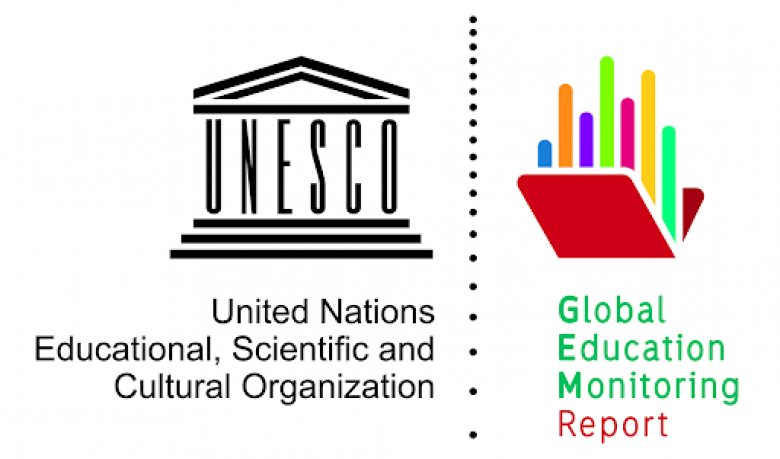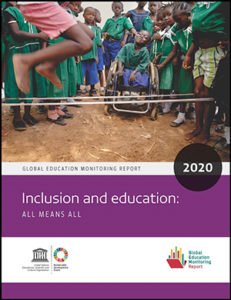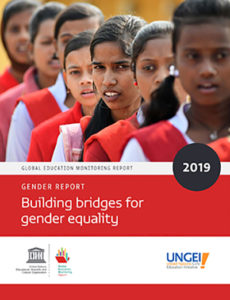Each year the Global Education Monitoring Report (GEM Report) takes an in-depth look at the global state of education. The one they’re preparing for next year focuses on the role of technology in promoting education under the terms set out in the Sustainable Development Goals (SDGs). We tell you about their lines of research below.
THREE QUESTIONS TO UNDERSTAND THE GEM REPORT
What is this?
As we all know, the 4th Sustainable Development Goal (ODS 4 in its Spanish initials) proposes that the world should strive to ensure inclusive and equitable quality education and promote lifelong learning opportunities for all.
The GEM Report is an international instrument published by UNESCO that analyses, summarises and presents data, research and evidence with regard to the state of education around the world. It also makes recommendations to encourage reflection and dialogue and improve the formulation of education policies. It seeks to steer and support the action of the formulators of education policies to promote the achievement of SDG 4.
What does it discuss?
With 16 issues between 2002 and 2020, the GEM Report forms an essential part of the global educational architecture. Each issue focuses on a specific topic related to education and comprehensively and thoroughly analyses it from multiple standpoints. Thus, the topics covered in its 16 issues have included: Gender and education for all, the quality of education, early childhood education, education in contexts of migration and displacement, inclusion and the influence of non-state players on education.
Who uses the GEM report?
Some of its users include governments (including leaders and senior officials at the ministries of education and finance and the implementing bodies), experts (academic researchers, think tanks and consultants), multilateral, international, regional and national development organisations, teachers and their unions, young people, students and their representative organisations, civil society and non-governmental organisations involved in education and the general public.
2023 GEM REPORT: TECHNOLOGY AND EDUCATION
Technology appears in six of the ten targets of the fourth Sustainable Development Goal regarding education. According to the Incheon Declaration, the achievement of this SDG depends on the opportunities and challenges posed by technology. While this was true in 2015 when the Declaration was signed, it’s even more so now, in view of everything that’s happened in the wake of the COVID-19 pandemic.
Moreover, technology applied to education is the subject of intense debate between technophiles and technosceptics, whose arguments for and against the use of technology in education are shaping a dialectic that’s increasing the number of challenges currently facing many education systems. The democratisation of knowledge or a serious threat to democracy? An opportunity for everyone or a monopoly of the few? A promoter of equality between countries or a generator of inequalities? An ally or enemy of cognitive development?
How can we resolve this debate? UNESCO asks this question in its recently published concept note on the GEM Report. “Technology is moving so fast that reflection and an evaluation of its effects are always lagging behind”, it continues. “Research into technology is both complex and necessary”.
Therefore, as could not be otherwise, the 2023 GEM Report will naturally address the educational challenges for which technology can offer solutions and the conditions that need to be in place in education systems to enable technology at schools to reach its full potential. In the following lines we’ll summarise the terms of reference of its research, which are developed in the concept note.
Which problems can technology resolve?
To deal with the question properly we need to focus on the kind of education we want and the main challenges we face in seeing this vision fulfilled. And this is where technology comes in. Only then do we need to consider whether technology can help to overcome these challenges and how it will do so. What are these challenges and how are each of them related to education? The GEM Report puts it in the following terms.
Access, equity and inclusion
How can we provide education to all the students who are difficult to reach? How can more knowledge be brought to more students in more attractive and affordable formats?
Technology is a powerful tool for overcoming inequalities related to two dimensions, namely serving disadvantaged populations and ensuring that the contents reach everyone in more attractive and affordable formats. This dimension brings with it challenges linked to access divides that even affect those who have access to technology (e.g. women and girls).
Quality
How can pedagogy be transformed to engage students and improve learning? How can education systems provide the new skills required by technology?
Education systems can use technology to improve the acquisition of basic skills, but the definition of these skills continues to expand as technology transforms the world. Thus, in terms of basic skills, technology can help teachers to provide more opportunities in order to focus on disadvantaged pupils who start at a disadvantage for a variety of reasons (they don’t receive enough encouragement at home, they have no pre-school education, they have difficulty in doing their homework, etc.). Moreover, as technology becomes more and more present in everyday life, students need skills to cope with the digital world and, through them, explore new ways of developing competences to participate in the working, social and political spheres. People need to “access, manage, understand, integrate, communicate, evaluate and create information” in a critical manner for multiple purposes. These are digital skills.
The way in which education systems address these new and constantly-evolving goals also poses major challenges; they must assess and anticipate the need for skills, develop competence frameworks, publish guidelines, draw up study plans, update textbooks and make them more dynamic and interactive, design courses and allocate funding.
Technological development
How can education systems support technological development?
Technology is in itself a subject that’s taught at all levels of education, but particularly in post-secondary education. The application of technology is redefining education and training. Technical, vocational and higher education institutions must therefore update their curricula, purchase equipment, anticipate future needs and validate skills, as technology is changing very rapidly and transcending disciplines. They also need to attract income from technological companies seeking to partner them and compete for students.
System management
How can the evaluation and other education management data be made more relevant and more widely used?
Technology can improve data collection and analysis to facilitate educational decision-making and practices.
WHAT THE REPORT WILL COVER
Access to technology
How can education systems ensure that all students have access to technological resources?
The report will look at how access to technology in education is distributed within and between countries (infrastructure and networks, electricity and the Internet, access to individual devices), programmes that offset the lack of access to electricity and the Internet and how to adapt the contents to different social and cultural contexts. Public policies that promote technology provision will also be examined.
Governance and regulation
How can education systems protect students from the risks of technology?
The report will examine how many countries are making progress in establishing structures to promote privacy and security standards and regulations and legal protection. It will also analyse the challenges associated with certain technologies. Artificial intelligence applications raise ethical issues and pose potential threats to the right to education.
Teacher preparation
How can education systems support all teachers and enable them to teach, use and manage technology effectively?
The success of the integration of technology, in other words, the routine but reflective use of technology to enhance learning, is closely linked to teachers’ practices. The barriers to teachers’ use of technology can currently be divided into three categories, related to access, use and organisation.
KEY QUESTIONS THE REPORT WILL ATTEMPT TO ANSWER
Having established the educational challenges for which technology could provide solutions and the conditions that need to be in place for the above to happen, the 2023 GEM Report will attempt to answer the following questions:
- What do we know about the role of technology when it comes to addressing each of the educational challenges identified with regard to access, equity, inclusion, quality, technological development and the management of the education system?
- What do we know about the potential negative impact of technology on the educational challenges in each of these areas?
- How do countries provide access to technology to ensure that there are no gaps between different students and schools?
- How do education systems incorporate the use of technology by reforming curricula, redesigning didactic materials and supporting teachers?
- How can education address the negative consequences of the use of technology and the impact these are having on teaching?
The answers to these questions through reliable data and research will constitute a valuable working tool for all the institutions that are striving for more inclusive, more equitable and better education for all children.








